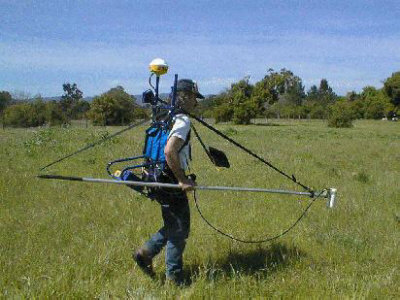
Optically pumped quantum magnetometers for searching for explosive objects.
ZVEZHINSKY Stanislav Sigismundovich, Professor, Doctor of Technical Sciences
JSC NPK Dedal, Leading Researcher
PARFENTSEV Igor Valerievich, Candidate of Technical Sciences
FSUE «15th Central Research Institute of the Ministry of Defense of the Russian Federation named after D.M. Karbyshev», Head of Department.
Source: magazine «Special Equipment and Communications» No. 3 2009
The review analyzes the main technical characteristics and application of modern quantum magnetometers with optical pumping for searching for explosive objects.
Reliable and effective search for explosive objects (EO) in sheltered environments is a problem of global significance, its relevance does not decrease due to ongoing local military conflicts, residual phenomena from the Second World War, non-accession to the UN Convention on the Prohibition of Anti-Personnel Mines and the increase in production of leading countries — manufacturers of ammunition and mines.
One of the most effective is the passive method of searching for VOPs, based on the registration of magnetic anomalies caused by the ferromagnetic shells of such objects, which acquire magnetization in the Earth's magnetic field (EMF) [1].
The method is implemented using magnetometric converters (MC) or magnetometers, including those switched on differentially on a «rigid» base of 0.25…1.7 m, forming a gradiometer.
Of these, the most widely used are ferroprobe detectors, since in most cases they best meet the “price – quality” criterion.
Quality is understood as a set of basic tactical and technical characteristics (TTC) – threshold sensitivity (at the level of doubled intrinsic peak noise) and the associated width of the detection zone (DZ) and depth of detection of ferromagnetic objects, weight and dimensions (the search is carried out by a human operator), search rate, continuous operation time, operating temperature [1, 2].
However, if the dominant performance characteristics are the achievable sensitivity or depth of the search for the VOP, then it turns out that fluxgate magnetometers are inferior to another class of special equipment — quantum magnetometers (QM) with optical pumping, the operating principle of which is based on the Zeeman effect.
In this case, the initially opaque vapor of the working substance — an alkali metal (non-radioactive cesium, potassium, previously — rubidium), located in a sealed cell — an electron-optical sensitive module (EMS), is irradiated (pumped) with polarized monochromatic light, the wavelength of which corresponds to the spectral line of the substance.
The light is absorbed, and the atoms, being excited, move from the 2nd to the 3rd energy level — the vapor becomes transparent.
After a short time (~1 μs), the atoms spontaneously move to levels 1 (completely filling it) and 2 (not filled).
HF magnetic depolarizing field with a frequency of f(provided by a solenoid), corresponding to the difference in energy of these levels, moves electrons from the 1st level to the 2nd, and the steam again becomes less transparent.
The occurring precession of electrons at the Larmor frequency f is proportional to the magnitude of the surrounding magnetic field (determined by the EMF and the anomaly). The intensity of light registered by the photodetector changes with the same frequency.
The signal from the photocell is amplified and fed to the solenoid, implementing an auto-tuning high-frequency oscillator, the resonant frequency of which is proportional to the modulus of the magnetic field induction, and its change is proportional to the useful signal from the anomaly.
The measuring part of the CM is essentially a photodetector and a high-precision frequency meter operating in the periodic counting mode — the longer the period, the higher the resolution [3].
The guidance material of the US Army Corps of Engineers notes that in modern practice of searching for explosive remnants of war, only the following two types of MF have found application [4]:
- ferroprobes − relatively cheap, reliable, robust, with low energy consumption, operating in a wide temperature range, allowing for the search for explosive remnants at depths of up to 5 m “on the move” at a speed of up to 1.5 m/s (for example, products from Forester, Ebinger, Vallon, CST) [2, 5];
- quantum magnetometers with optical pumping− more sensitive and expensive, consuming an order of magnitude more electricity, less durable, requiring a certain amount of care in handling, operating in a narrower temperature range, used primarily for mapping magnetic anomalies, subsequent detection and identification of explosive remnants (for example, products from Geometrics, Scintrex, GEM Systems) [4, 6, 20].
Indeed, as analysis shows [5 − 9], other types of magnetic fields have not found application in searching for explosive remnants due to technological, cost and operational reasons:
- low threshold sensitivity (magnetotransistor, Hall sensor, magnetoresistor [10, 11]);
- impossibility of implementing two converters with similar parameters (based on thin magnetic film [12]);
- impossibility of measuring a constant or extremely low-frequency magnetic field (induction variometer [13, 14]);
- large dimensions, energy consumption and very high cost due to cryogenic technology (SQUID [15-17]).
Optically pumped CMs are sometimes used in conjunction with a proton precession magnetometer, which acts as a base station recording fluctuations in the magnetic field in order to exclude them from the measurement results.
Compared to CMs, proton MFs have 1-2 orders of magnitude lower sensitivity (~0.1 nT) and response speed (conversion frequency ≤1 Hz), are unstable and even fail to function at high gradients of the measured field, but they are less expensive and are not affected by shaking and vibration.
The Overhauser magnetometer, while retaining the positive qualities of the proton magnetometer, has a better response speed (conversion frequency ≤5 Hz), sensitivity close to the CM (~0.02 … 0.03 nT), but it is characterized by a shorter lifetime of the working substance, an increased systematic error due to the influence of the microwave unit [18].
CM are scalar, do not have a sensitivity axis, and cannot provide information on the direction of the magnetic anomaly induction vector B.
However, this quality allows for the construction of more accurate gradiometers (than in the case of ferroprobes), devoid of angular error [1, 2].
CMs are characterized by a very high cost on the world market (tens of thousands of dollars), sensitivity to mechanical impacts, the presence of a mandatory angle between the FM axis and the MPZ vector of no less than a specified one (“dead zone”), and the optimal angle (for minimum noise) is about 450.
If we compare MPs by the working substance used in the FM, then potassium ones have certain advantages over cesium ones, providing [6, 23]:
- the highest (of all optically pumped CMs) threshold sensitivity at the level of 1 pT (5…10 pT for cesium ones);
- high absolute measurement accuracy (no more than 1 nT), necessary for the implementation of a gradiometer (2..3 times higher for a cesium one);
- higher (2…3 times) response speed — up to 20 meas./s;
- practically zero heading error (~0.1 nT), arising from the rotation of the module in the MPZ (~1 nT for a cesium one);
- absence of periodic calibration (cesium has parasitic sensitivity to the position of the depolarizing solenoid), less labor-intensive maintenance (less sensitive to shaking).
The advantages of potassium CM are due to the narrowest (less than 1.0 nT, for cesium — 20 nT) spectral absorption line and a high conversion coefficient of the Larmor frequency of 7 Hz/nT (for cesium it is 2 times less).
However, potassium CMs are generally more expensive, and their operation is more limited in fields with a high gradient, caused, for example, by the presence of nearby metal structures, barriers, and pipelines.
The gradiometer, eliminating the influence of the constant MPZ on the measurement results, provides a greater «contrast» of the target in relation to the surrounding noise.
To search for VOPs, a horizontal gradiometer is usually used, where both CMs are located at the same height perpendicular to the search route.
This allows for a greater depth of search for the VOP and a greater width of the ZO compared to a magnetometer or vertical gradiometer, in which the FM is located at different heights from the surface.
Modern CMs, in addition to the main functions, have many additional ones that facilitate or complement magnetic survey.
Most models have continuous recording while moving (“walking”), which is supplemented by synchronous data from an external or built-in GPS system (DGPS).
A high measurement frequency (typically at least 5 measurements/sec) allows for data accumulation with better spatial resolution at the expense of some increase in intrinsic noise.
All products have a precise built-in clock, significant internal memory, an RS-232 interface for sending data to a computer, and specialized software for processing results.
The graphic display allows you to view the magnitude and other service information during the search.
Most models have the ability to operate in gradiometer mode (when installing a second FM), and the index «G» is usually added to the name.
Below we analyze the capabilities of optically pumped quantum magnetometers from various manufacturers for searching for explosive remnants of war.
There are two main operating modes to distinguish:
1) in the case of demining «on the fly» (for example, by sappers);
2) in humanitarian demining (mapping magnetic anomalies), when it is important to ensure maximum accuracy and sensitivity, and the search speed is not so important.
Quantum magnetometers, which are very expensive and sensitive, are mainly used in the second mode.
Quantum magnetometers/gradiometers from Geometrics
The quantum magnetometer G-858 with optical pumping of non-radioactive Cs133 vapors (manufactured by Geometrics, San Jose, USA, has existed since 1969) has firmly entered the list of products used to search for explosive remnants [19 − 21].
Since its introduction in 1996, the company has sold more than 500 G-858 products, its commercial success is associated with archeology, treasure hunting and old valuable items, providing a significantly greater search depth than fluxgates.
The product is supplied to the US Army Corps of Engineers and is used by Sandia National Laboratory (Sandia Labs), the leading US scientific military-technical center. G-858 can operate in magnetometer or gradiometer mode (photo 1), its sensitivity, resolution and data recording speed are selected by the operator.
It achieves high threshold sensitivity (4 ranges), which depends on the measurement cycle (sampling): 0.01 nT at a measurement frequency of 1×s-1 and 0.05 nT at a frequency of 10×s-1.
The search rate in magnetometer mode reaches 8×103 m2/h (in horizontal gradiometer mode — 2 times more), the signal about the presence of explosives is visualized on the LCD display and sounds in the operator's headphones. A ferromagnetic cube weighing 1.8 kg at a distance of 3.7 m is typically used to calibrate the product.
G-858 consists of a sensitive module (SM), an electronic unit (EU) with an LCD display, a design and a power supply.
SM is a cylinder with a diameter of 64 mm, a length of 152 mm and a mass of 0.34 kg.
The BE, mounted on a non-magnetic backpack, provides the operator with real-time information, allowing magnetic measurements to be made along a pre-set coordinate grid without markers.
The BE has a built-in AG114 GPS receiver (weight 0.76 kg) with differential location correction and an accuracy of up to 1.5 m (photo 1).
Radio beacons can also be used to ensure greater accuracy.
The total weight of the product together with the GPS module is ~16 kg, the 24 V DC power supply is provided by a battery (weight 4.5 kg); it is enough for 6-8 hours of continuous operation in magnetometer mode (current consumption is 0.5 A) and 3 hours in gradiometer mode with GPS.
Photo 1. G-858 with a GPS antenna in the single magnetometer mode
A portable version of the G-858 gradiometer is also possible, when two FMs are located at a distance of 1 m from each other on a rigid structural base such as a wheeled «trolley» made of non-magnetic materials, with a total mass of 32 kg.
The operator (vehicle) moves it behind itself, while providing a ZO of at least 2.5 m in width and a high search rate — over 104 m2 /h (photo 2).
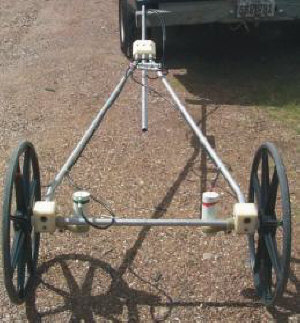
Photo 2. Gradiometer G-858 on a wheelbase
The sound signal can be one of three options:
- a tone reflecting the magnitude of the magnetic field variation;
- pulse metronome of the speed of movement with an interval of 1 s;
- alert about the discharge of batteries or failure of the set measurement parameters.
The graphic LCD display 320×200 pixels displays:
- up to 5 magnitudes of the magnetic field module with a resolution of 0.1 nT (gradient — 0.1 nT/m);
- setting search parameters;
- the values of the full magnetic field, noise level, route coordinates;
- product diagnostics.
Measurement data (with attached GPS coordinates) are accumulated in the BE, its internal memory is enough for 8 hours of recording in magnetometer mode or 3 hours of gradiometer at the maximum sampling frequency (10 meas./s), which allows for fast-paced shooting.
Then they are transferred (RS-232) to the computer for further analysis, using specialized software «MagMap2000», which has a graphical interface for visualizing the magnetic anomaly map.
Data from «MagMap2000» can be exported for additional analysis, carried out, for example, using the well-known programs «Surfer», «Geosoft».
When searching, route numbers, landmarks are used to determine the map parameters, or the entire grid is specified, and the operator can see his location and the current profile (magnitude) on the display.
If accuracy better than 1 m is required, and measurements are made under trees or on terrain with complex relief, then the GPS system is ineffective and other positioning systems can be used.
For the operation of G-858the longitudinal axis of the FM should form an angle of 15…750 relative to the vector BMPZ of the MPZ induction.
In addition, the product is not operational at induction gradients above 20 μT/m, therefore, the presence of large metal structures (e.g., a car, a mesh fence) at a distance closer than 4 m from the route is not allowed on the ground.
Limitation of the functional capacity of the product G-858is also a temperature range of 25…+500 C and the magnitude of the induction of the surrounding field is no more than 105 nT, 2 times greater than the typical MPE [21].
So in areas with global magnetic anomalies, the product may be inoperative.
The temperature drift of 0.05 nT/0C, which limits the accuracy of measurements, is not so important when searching for high-frequency objects. Mechanical vibrations can change the relative position of the high-frequency coil and the optical axis of the FM, which for cesium CMs should be very stable.
This necessitates its regular balancing, − if this is not done, the difference in the course error between the two FM gradiometers can lead to errors comparable to the value of the measured magnitude.
The G-858 product in a static state detects objects with a ferromagnetic mass of 110 kg at a depth of 15 m; 13 kg — 7 m; 2 kg — 3 m [20]; according to other data, an iron barrel is detected at a depth of 6 m, 0.9 kg — 2.5 m; 0.5 kg — 2 m [21].
Despite the existing shortcomings, G-858has high performance characteristics (for a portable field product); compared to the world's best ferroprobe gradiometer FEREX 4.032, the depth of search for explosives is increased by ~2.5 times [2].
The cost of the G-858 magnetometer (with GPS) in the USA is ~25…30 thousand dollars, the G-858G gradiometer together with the MagMap2000 software costs 44 thousand dollars (as of 2007) [2].
Quantum magnetometer Geometrics G-859 appeared on the market in 2005, it is a simplified and cheaper (by about 40%) modernization of the product G-858.
The cesium FM is almost identical to the early model (weight 0.34 kg, diameter 6 cm, length 15 cm), the sensitivity has also not changed.
Their own weight has been reduced by 2 times, the power consumption has been reduced, the continuous operation time is 6 hours together with the new Novatel Smart GPS module (WAAS/EGNOS).
The GPS module consumes 1.4 W, the location accuracy is 0.75 m.
The design assumes the backpack placement of the BE and the power source (gel battery), the FM and GPS antenna are located on non-magnetic rods (photo 3).
Gradientometric inclusion of two FM is not provided.

display (a);
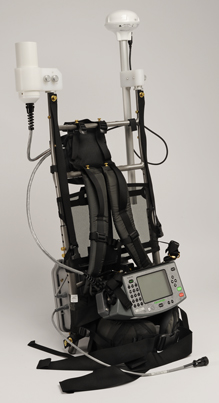
appearance (b);
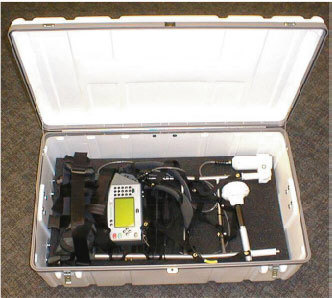
product kit (c)
Photo 3. Quantum magnetometer G-859
There are 3 sensitivity ranges (measurement cycles), the fastest cycle — 5 meas./s. corresponds to the threshold sensitivity of 30 pT, the slow cycle (1 meas./s) — 10 pT.
Sensitivity G-859 by rms. is 8 pT/Hz0.5, the product is resistant to external magnetic field gradient up to 20 μT/m.
It provides 50/60 Hz interference suppression, it no longer requires periodic calibration or adjustment, the FM is characterized by increased mechanical strength.
The operating temperature range remains the same, which limits its use for searching for explosive remnants.
As in the previous model, for the G-859 to function, it is necessary to ensure an angle of 10…800 between the optical axis of the FM and the vector of the MPZ, for a better signal-to-noise ratio, the angle should be within 15…750.
The magnetic field induction measurement range is (1.7…10)×104 nT.
Digital data during measurements can be accumulated in the BE for 8 hours of continuous operation (up to 250 thousand measurements with GPS coordinates); they are transferred to a computer with the MagMap2000 software via the RS-232 port.
A magnetic anomaly map is created in the field using the MagMap2000 software.
The G-858, G-859 products have 4 main operating modes:
- measuring the magnetic field and recording the results together with GPS data, which are usually received once every 1 second;
- searching for anomalies, while the magnitude is reflected on the monochrome LCD display (measurement data is not recorded), sound appears when a significant signal is detected;
- recording data without reference to GPS using a cable, markers;
- a base station recording magnetic field fluctuations at the measurement site.
For shallow and deep-water search for magnetic anomalies (including VOP), there is a Geometrics G-882 product with a threshold sensitivity of 0.01 nT (0.1 s measurement cycle) or 0.001 nT (1 s cycle).
The cesium FM is operational at a temperature of 35…+500 C, the current consumption from a 24…32 V source is 0.5 A.
The heading error is no more than 1.0 nT, the absolute measurement accuracy is at least 3.0 nT. The product weighs about 16 kg, power consumption is 12 W in operating mode and 24 W when switched on (heating the FM).
G-859 is more suitable for explosive remnants of war than G-858 (primarily due to its lower price and increased strength).
However, its narrowed temperature range and the absence of a gradiometer (in order to expand the detection zone and increase the search rate) limit its capabilities.
Quantum magnetometers from Scintrex
Scintrex Ltd.(Toronto, Canada) both manufactures complete devices and supplies individual quantum magnetometers (type CS-3, CS-3L).
The quantum magnetometer/gradiometer SmartMag (NATO abbreviation V-90) with optical pumping of cesium vapor was released to the market in the late 80s (modifications SM-1, SM-3 − with a simplified electronic unit, SM-2 − essentially a magnetometric transducer), it was intended for geophysical research, searching for explosive remnants (and other objects — ferromagnetics) [25].
When developing the product, the V-92 Scintrex metal detector was taken as a basis.
In the first half of the 90s, the latest modifications were released — SM-4 (photo 4a, b) and SM-4G − gradiometer (photo 5).
High sensitivity and speed of SmartMag, as well as a wide range of operating temperatures were the reason for the ban on export of the product from Canada (COCOM restrictions).
SmartMag SM-4 is a compact and relatively lightweight device (photo 4), it includes:
- FM on an aluminum rod, connected to the BE — preamplifier;
- backpack — supporting structure;
- console with LCD display;
- compartment with 2×12 V (4 Ah) gel batteries, which are attached to the operator's belt at the back.
An option is headphones connected to the console when searching for explosive devices.
The batteries support continuous operation for 20 hours at +200 C; to power the product, it is possible to connect an external 12 V battery, such as a car battery, to the console.
The FM is waterproof (IP67), the other units are dustproof.
The internal memory is sufficient to record 310 thousand measurements in magnetometer mode and 190 thousand in gradiometer mode, so that via RS-232 (RS-422 for SM-2) the data can be transferred to a computer to compile an anomaly map using specialized software «Envimap».
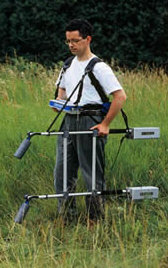
a — in work;
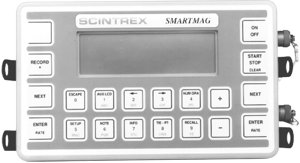
b − console with LCD display and buttons controls
Photo 4. Quantum Magnetometer SmartMag SM >-4:
The CM (diameter 63 mm, length 16 cm) weighs 2.1 kg together with the rod and electronic unit, overall dimensions (length) are 120 cm.
The design allows for the implementation of a vertical gradiometer with a base of 0.5 m and a horizontal gradiometer with a base of 0.5; 1.0; 1.5 m.
The selection of operating modes and control of the product is carried out from the console (19 control buttons) using a monochrome LCD display with a resolution of 64×240 pixels, which displays, among other things, the magnitude, allowing you to analyze the characteristics of magnetic anomalies (the image is available in any lighting conditions).
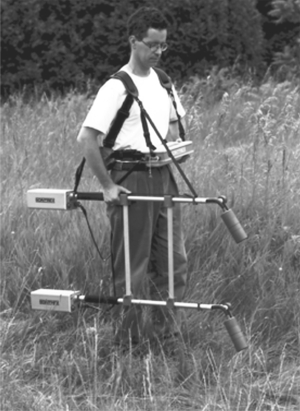
a)
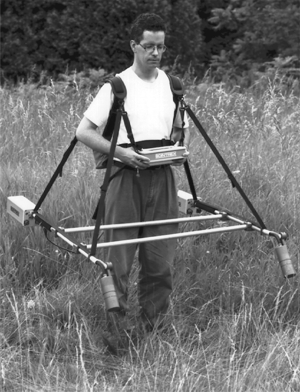
б)
Photo 5. Quantum gradiometer SmartMag SM-4G:
a − vertical with a base of 0.5 m;
b − horizontal with a base of 1.0 m
In the product, you can select not only the measurement cycle (1, 2, 5, 10 meas./s), but also the range of recorded frequencies (0.5; 1; 2; 4; 8 Hz), reducing sensitivity to interference.
There are 3 basic operating mode settings:
- search for explosive devices;
- detection of pipes and metal communications;
- archaeology.
Technical characteristics of the SmartMag product are presented in Table 1.
At present, the product is outdated (for example, there is no internal GPS function), samples are sold in Russia and third world countries at reduced prices.
Judging by the publications, SmartMag SM-4 is still widely used in archaeological and geophysical research abroad.
Cesium magnetometer/gradiometer NavMag SM-5 is a new, modern product Scintrex (on the market since 2004), its performance characteristics are given in Table 1.
NavMagprovides the highest (for cesium devices) sensitivity — no worse than 0.01 nT for any of the 4 set measurement cycle ranges — from 1 to 10 meas./s, operates in an extended temperature range from 300 C.
Compared to SM-4, the new product has innovations, the main one of which is the built-in GPS function with an accuracy of no worse than 5 m (photo 6); it is possible to connect an external DGPS with an accuracy of up to 1 m.
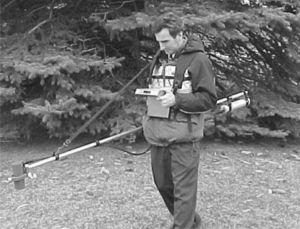
a)
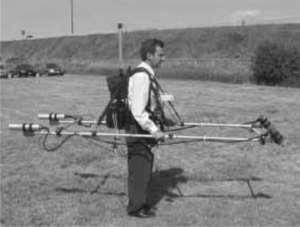
б)
Photo 6. NavMag SM-5: in magnetometer mode (a)
and horizontal gradiometer c internal antenna GPS (б)
Product NavMag SM-4 includes:
- World Cup type CS-3 (photo 7) with an electronic unit, placed at different ends of the aluminum rod (for the gradiometer — 2 pcs.);
- backpack-constructive (photo 7);
- console with control buttons and a color VGA display, 640 × 480 pixels (photo 8);
- power supply;
- GPS module.
Simple and lightweight design ensures the implementation of a vertical and horizontal gradiometer. Warm-up time (cesium FM) to suitable conditions is 15 min.
The power supply consists of 4 12 V batteries (5.0 Ah).
The display has a Windows-like menu, the advanced interface allows you to import data directly to a personal computer.
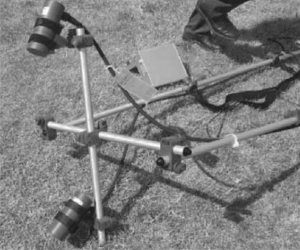
a)
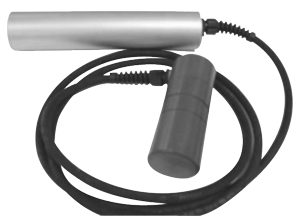
б)
Photo 7. NavMag SM-5:
design for vertical gradiometer (a),
sensitive module with electronic unit (b)
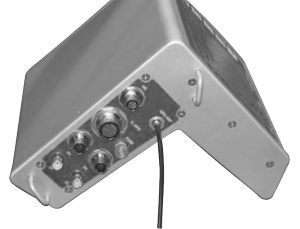
Photo 8. ConsoleNavMag SM-5
NavMag to the greatest extent, than the above-mentioned KMs, meets the requirements for products intended for the search for explosive remnants, and, above all, in terms of maximum sensitivity, temperature range, and the ability to operate in the horizontal gradiometer mode (with a base of 0.5 or 1.0 m).
In the latter case, the width of the zone can reach 3 m, and the depth of the search for the VOP — up to 10 … 12 m. The cost of the NavMag gradiometer in the USA is about 40 thousand dollars.
Table 1. Tactical and technical characteristics of quantum magnetometers with optical pumping of cesium vapor (Geometrics, Scintrex)
| Technical specification | Company, product | |||
|---|---|---|---|---|
| Geometrics | Scintrex | |||
| G-858 | G-859 | SmartMag SM-4 | NavMag SM-5 |
|
| Threshold sensitivity, pT, during a measurement cycle: | ||||
| 1 s (1 mea. /с) | 10 | 10 | < 10 | < 10 |
| 0.5 s (2 changes/s) | 20 | 20 | < 10 | < 10 |
| 0.2 s (5 changes/s) | 30 | 30 | < 10 | < 10 |
| 0.1 s (10 changes/s) | 50 | — | 10 | 10 |
| Sensitivity (rms), pT/Hz0.5 | 4 | 8 | 3 | 3 |
| Absolute accuracy, ± nT, no less | 2.0 | 1.0 | 1.0 | |
| Heading error, ± nT, no more (with FM rotation 360…) |
0,5 | 0.5 | 1.0 | 1.0 |
| Temperature drift, nT/°C, no more than | 0.05 | 0.05 | 0.01 | |
| Operability at an angle between the MPZ vector and the FM axis, deg | 6…84 94…174 |
6…84 94…174 |
10…85 95…170 |
10…85 95…170 |
| Optimum angle between MPZ and FM axis, deg (to minimize noise) |
45 ± 30 | 45 ± 30 | 40…80 | 40…80 |
| Dynamic range of measurements, µT | 17…100 | 18…95 | 15…100 | 20…100 |
| Limitation on the permissible field gradient, µT/m, no more | 20 | 20 | 40 | |

Добавить комментарий